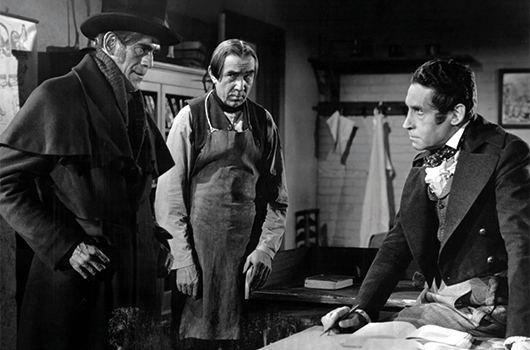
Body Snatcher, The (RKO 1945)
by Nige Burton
The Val Lewton RKO psychological horror pictures of the 1940s tend to be universally regarded as some of the finer entries into the genre. However, these stylish noir thrillers could easily have been stopped in their tracks when a Universal producer jumped ship to RKO in 1943 and was given the task of supervising Lewton’s ongoing activities.
Lewton was wary of Jack Gross, whom he described as “an abysmally ignorant and stupid gentleman… who has been making those Universal horror films and so had a particular grudge against me”, and the executive producer immediately seemed to prove the producer right by insisting that Boris Karloff, fresh from 1944’s House of Frankenstein, be hired for the next production.
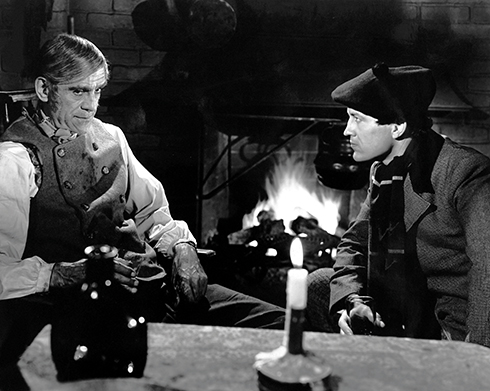
Concerned for the welfare of Georgina Marsh, Donald Fettes (Russell Wade) entreats Cabman John Gray (Boris Karloff) to procure a new dissection subject in The Body Snatcher (RKO 1945)
A meeting with Karloff soon impressed Lewton enough for him to realise he was dealing with a staunchly professional performer. The pair collaborated on 1945’s Isle of the Dead, but shooting had to be paused due to a resurgence of Karloff’s debilitating back trouble, and when the cast could not be reconvened in time for filming to begin again at once, it was decided that the next project would be squeezed in.
Gross went even further; if the film was going to have of Karloff, why not have Bela Lugosi too? The question arose as to what source material could provide a relatively quick turnaround shoot before the resumption of Isle of the Dead, but the conundrum was soon solved, and Robert Louis Stevenson’s ‘The Body Snatcher’ was chosen as the next project.
Considering it was shoehorned in to fill a gap while Isle of the Dead had been paused, The Body Snatcher has managed to sustain a reputation for being one of the most respected horror films not just of its day, but of the genre as a whole. It pretty much fails to put a foot wrong from the outset, and given the brilliance of Lewton’s remarkable hands-on flair, Robert Wise’s pitch-perfect direction and Karloff’s masterfully standout delivery as the sinister Cabman John Gray – in fact, it is potentially the actor’s finest performance in a career of very fine performances – it is perhaps unsurprising that it survives as such a classic, even among the highly thought of RKO stable from which it emerged.

While Wolfe MacFarlane (Henry Daniell) attempts to come to terms with his apparent failure, John Gray (Boris Karloff) reminds him of their ugly shared history in The Body Snatcher (RKO 1945)
Lugosi too, in his tiny bit part of Joseph the porter, manages to shine as brightly as the rest of the movie and provide one of the most haunting sequences opposite his old sparring partner, although the Hungarian’s stint on the production was not without its problems, as Wise remembered: “He was not well at all, it was a small part that didn’t require too much out of him, but I had to kind of nurse him through the whole role, such as it was. I always appreciated Karloff’s sensitivity when it came to the scene where they played together in the film, where the Lugosi character came to see the Karloff character, that Boris was very, very gentle with him, knowing he was not well, and was very patient with him. I always respected Karloff for that, and the sensitivity in that situation.”
Stevenson’s short story was a starting point, but since Gray only appears a couple of times throughout the narrative some considerable work was required to flesh out the character for Karloff to have a meaty enough role. This was a task that fell to British novelist Philip MacDonald, who decided to take the Scottish author’s ending and work backwards, devising a central plot based around Stevenson’s main characters, doctors MacFarlane and Fettes, and their involvement with Gray.
Karloff’s realisation of Gray is sensational, creating a chillingly complex character who haunts the nightmares and daydreams of Dr Wolfe ‘Toddy’ MacFarlane (Henry Daniell), the outwardly upstanding physician who has systematically lost his soul to his life’s previous events. Although he and Gray appear as chalk and cheese in both bearing and status, we soon come to realise that they are in fact all but melded into the same persona, each mirroring the other’s strengths, fears, depravities and peccadillos, both as culpable as the other.
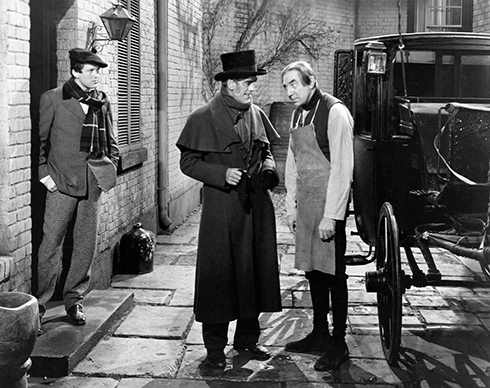
Though aware of some of Gray’s (Boris Karloff) deeds, Fettes (Russell Wade) has no idea that Joseph (Bela Lugosi) is soon to fatally involve himself in events in The Body Snatcher (RKO 1945)
On the 8th of September, 1944, MacDonald’s preliminary screenplay was sent to the Breen office, and their reply duly came some nineteen days later: “We have read, with close attention, your estimating script of September 8th for your proposed picture The Body Snatcher and regret to advise that this story is unacceptable under the provisions of the Code because of the repellent nature of such matter, which has to do with grave-robbing, dissecting bodies and pickling bodies. The undue gruesomeness which would unavoidably be attached to the picturisation of such scenes could in no wise be approved.” They subsequently recommended that the revised script take place “in some new locales, away from dead bodies, with new dialogue situations.” Lewton got to work and substantially revised the script himself, adding value to such significance that MacDonald implored him to take a shared screen credit for his work, which he did under his old pen name of Carlos Keith.
The finished iteration of The Body Snatcher is so far removed from Stevenson’s little ditty as to defy comparison, but it does remain almost entirely faithful to the author’s original denouement, which, with Gray out of the way at the lately murderous hands of MacFarlane and now safely dissected by his students, sees the increasingly amoral Fettes (Russell Wade) accompany his mentor on a resurrectionist mission, after which they load their freshly harvested corpse onto their sparse gig amid a raging thunderstorm.
As they push the horse for home, the shrouded body tosses first left and then right; MacFarlane becomes convinced that there has been a switch and, to Fettes’ confusion, orders that he pass him the light so he can see the cadaver’s face. Peering back at him is the intact body of Gray. The horrified doctor’s cries of alarm cause the horse to bolt; the carriage becomes separated and plunges down a ravine killing MacFarlane. As a rain-soaked Fettes catches up, he reveals that the body alongside him is still that of the woman they stole. In Stevenson’s supernatural twist, it is indeed Gray that has returned, a fact witnessed by both men, each of whom lives to tell the tale.
Lewton previewed The Body Snatcher to the trade press on Tuesday the 13th of February, 1945, after which the Hollywood Reporter called it: “an unqualified lulu certain to satisfy the most ardent chill and thrill craver, for this is about as grisly an affair as the screen has ever ventured to offer, a veritable orgy of killing and grave-robbing. … Robert Wise gives the picture distinctive direction, for Val Lewton this is another top production credit.” Similarly, the Motion Picture Herald opined: “Val Lewton, who has a way with weird and occult tales, has found one to his liking by an old master, and produced it with all the modern staging and lighting effects which have won him and the horror picture a considerable following.”
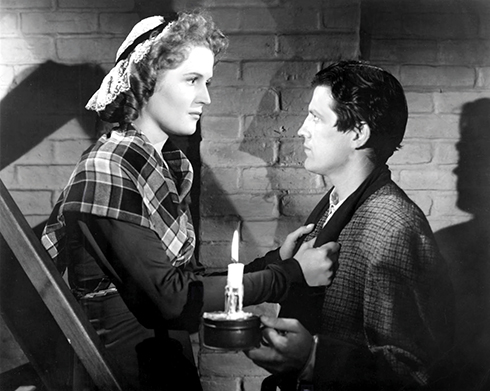
Meg Cameron (Edith Atwater) reveals to Donald Fettes (Russell Wade) the depth of connection between MacFarlane and Gray in The Body Snatcher (RKO 1945)
The film opened in Los Angeles on the 10th of May, and its performance surpassed even RKO’s expectations, smashing all previous first week box office takes at Hollywood’s Hawaii Theatre, and then did equally as well at New York’s Rialto on Friday the 25th of May, but Sid Kramer of RKO’s print department reported to the studio that The Body Snatcher had been “condemned in its entirety by the city of Chicago and the state of Ohio.” The Roman Catholic National Legion of Decency awarded the film an undesirable class B rating, stating that the movie was “objectionable in part due to excessive gruesomeness”.
It all seemed to matter little, with Time Magazine’s James Agee summing up that both The Body Snatcher and Isle of the Dead were among the best movies of 1945, and that Lewton’s work represented “some of the most sensitive movie intelligence in Hollywood”.
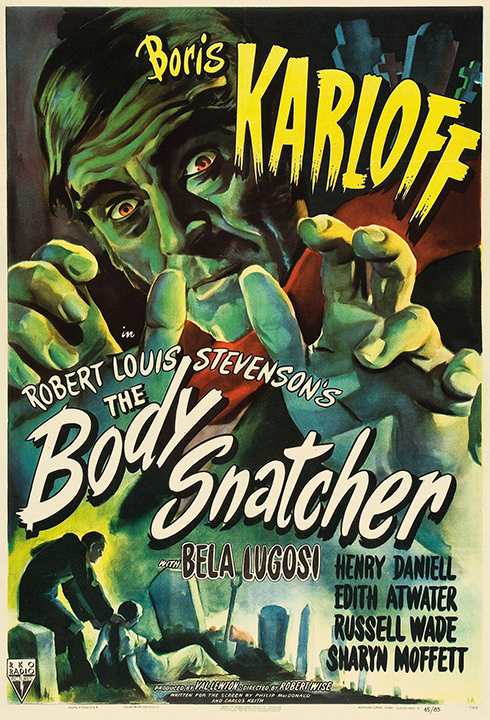
Poster art for The Body Snatcher (RKO 1945)
Nige Burton is the founder and editor of Classic Monsters of the Movies magazine. A lifelong horror film enthusiast, he contributes regularly to the genre through his range of publications. He is also a published novelist and photographer.





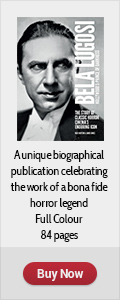
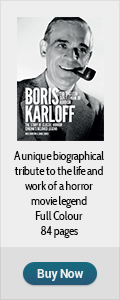



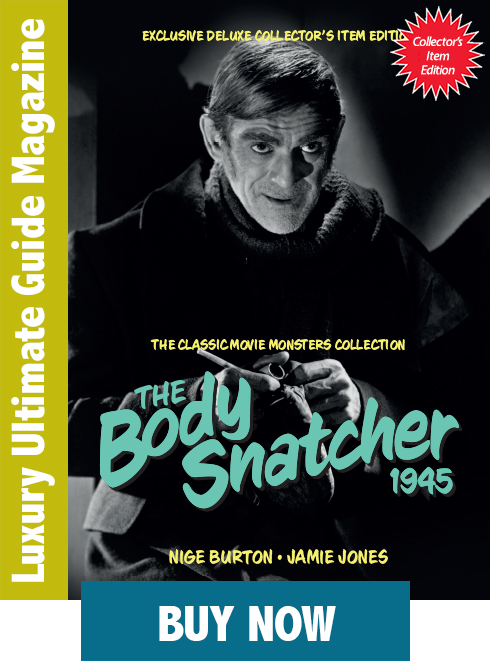
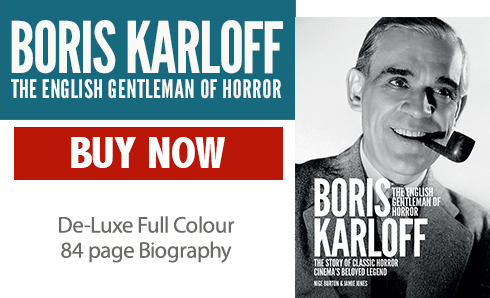
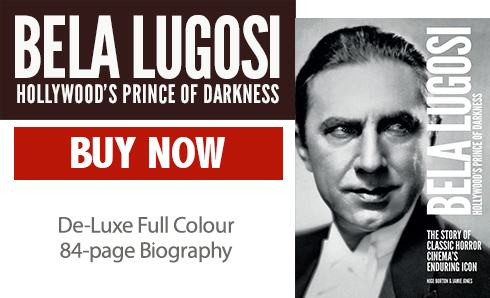
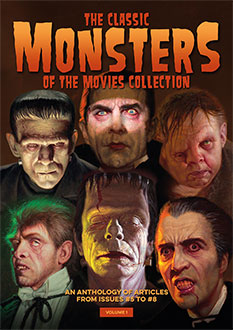
Leave a comment